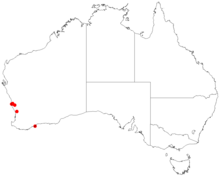Leucopogon plumuliflorus is a species of flowering plant in the heath family Ericaceae and is endemic to the south-west of Western Australia. It is a weakly erect shrub with egg-shaped leaves and spikes of white or pinkish-white, tube-shaped flowers.
| Leucopogon plumuliflorus | |
|---|---|

| |
| Scientific classification | |
| Kingdom: | Plantae |
| Clade: | Tracheophytes |
| Clade: | Angiosperms |
| Clade: | Eudicots |
| Clade: | Asterids |
| Order: | Ericales |
| Family: | Ericaceae |
| Genus: | Leucopogon |
| Species: | L. plumuliflorus
|
| Binomial name | |
| Leucopogon plumuliflorus | |

| |
| Occurrence data from AVH | |
| Synonyms[2] | |
| |
Description
editLeucopogon plumuliflorus is a slender, weakly erect, multi-stemmed shrub that typically grows to a height of 30–60 cm (12–24 in), its branches and leaves more or less softly-hairy. The leaves are egg-shaped with a heart-shaped base, less than 13 mm (0.51 in) long and convex, with the edges turned down. The flowers are arranged in spike-like heads on the ends of branches, with small bracts and hairy, egg-shaped bracteoles 1.6 mm (0.063 in) long. The sepals are linear to lance-shaped, 5.3 mm (0.21 in) long, the petals white or pinkish-white, 3.2 mm (0.13 in) and joined at the base, the petal lobes shorter than the petal tube. Flowering occurs from April or from July to November and the fruit is a drupe.[1][3]
Taxonomy
editLeucopogon plumuliflorus was first formally described in 1867 by Ferdinand von Mueller who gave it the name Styphelia plumuliflora in Fragmenta Phytographiae Australiae from specimens collected by James Drummond.[4][5] In 1868, George Bentham transferred the species to Leucopogon as L. pumuliflorus in Flora Australiensis.[3][6] The specific epithet (plumuliflorus) means "little feather-flowered", referring to the sepals.[7]
Distribution and habitat
editThis leucopogon grows on lateritic sandy soils, amongst boulders and on hillslopes in the Geraldton Sandplains bioregion of south-western Western Australia.[1]
Conservation status
editLeucopogon plumuliflorus is listed as "Priority Two" by the Western Australian Government Department of Biodiversity, Conservation and Attractions,[1] meaning that it is poorly known and from only one or a few locations.[8]
References
edit- ^ a b c d "Leucopogon plumuliflorus". FloraBase. Western Australian Government Department of Biodiversity, Conservation and Attractions.
- ^ a b "Leucopogon plumuliflorus". Australian Plant Census. Retrieved 10 April 2023.
- ^ a b Bentham, George (1868). Flora Australiensis. Vol. 4. London: Lovell Reeve & Co. p. 205. Retrieved 10 April 2023.
- ^ "Styphelia plumuliflora". APNI. Retrieved 10 April 2023.
- ^ von Mueller, Ferdinand (1867). Fragmenta Phytographiae Australiae. Vol. 6. Melbourne: Victorian Government Printer. pp. 29–30. Retrieved 10 April 2023.
- ^ "Leucopogon plumuliflorus". APNI. Retrieved 10 April 2023.
- ^ Sharr, Francis Aubi; George, Alex (2019). Western Australian Plant Names and Their Meanings (3rd ed.). Kardinya, WA: Four Gables Press. p. 280. ISBN 9780958034180.
- ^ "Conservation codes for Western Australian Flora and Fauna" (PDF). Government of Western Australia Department of Parks and Wildlife. Retrieved 10 April 2023.
